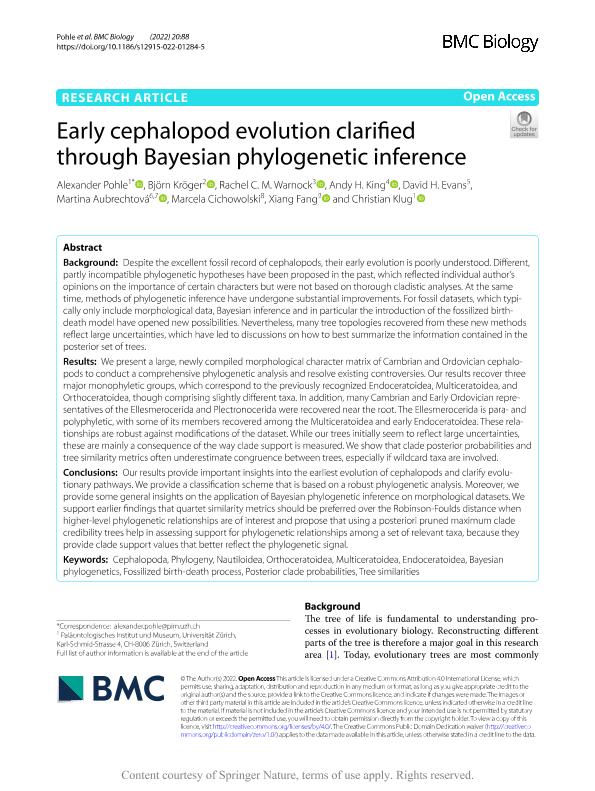Mostrar el registro sencillo del ítem
dc.contributor.author
Pohle, Alexander
dc.contributor.author
Kröger, Björn
dc.contributor.author
Warnock, Rachel C. M.
dc.contributor.author
King, Andy H.
dc.contributor.author
Evans, David H.
dc.contributor.author
Aubrechtová, Martina
dc.contributor.author
Cichowolski, Marcela

dc.contributor.author
Fang, Xiang
dc.contributor.author
Klug, Christian
dc.date.available
2022-08-25T18:38:46Z
dc.date.issued
2022-12
dc.identifier.citation
Pohle, Alexander; Kröger, Björn; Warnock, Rachel C. M.; King, Andy H.; Evans, David H.; et al.; Early cephalopod evolution clarified through Bayesian phylogenetic inference; BioMed Central; Bmc Biology; 20; 1; 12-2022; 1-31
dc.identifier.issn
1741-7007
dc.identifier.uri
http://hdl.handle.net/11336/166643
dc.description.abstract
Background: Despite the excellent fossil record of cephalopods, their early evolution is poorly understood. Different, partly incompatible phylogenetic hypotheses have been proposed in the past, which reflected individual author’s opinions on the importance of certain characters but were not based on thorough cladistic analyses. At the same time, methods of phylogenetic inference have undergone substantial improvements. For fossil datasets, which typically only include morphological data, Bayesian inference and in particular the introduction of the fossilized birth-death model have opened new possibilities. Nevertheless, many tree topologies recovered from these new methods reflect large uncertainties, which have led to discussions on how to best summarize the information contained in the posterior set of trees. Results: We present a large, newly compiled morphological character matrix of Cambrian and Ordovician cephalopods to conduct a comprehensive phylogenetic analysis and resolve existing controversies. Our results recover three major monophyletic groups, which correspond to the previously recognized Endoceratoidea, Multiceratoidea, and Orthoceratoidea, though comprising slightly different taxa. In addition, many Cambrian and Early Ordovician representatives of the Ellesmerocerida and Plectronocerida were recovered near the root. The Ellesmerocerida is para- and polyphyletic, with some of its members recovered among the Multiceratoidea and early Endoceratoidea. These relationships are robust against modifications of the dataset. While our trees initially seem to reflect large uncertainties, these are mainly a consequence of the way clade support is measured. We show that clade posterior probabilities and tree similarity metrics often underestimate congruence between trees, especially if wildcard taxa are involved. Conclusions: Our results provide important insights into the earliest evolution of cephalopods and clarify evolutionary pathways. We provide a classification scheme that is based on a robust phylogenetic analysis. Moreover, we provide some general insights on the application of Bayesian phylogenetic inference on morphological datasets. We support earlier findings that quartet similarity metrics should be preferred over the Robinson-Foulds distance when higher-level phylogenetic relationships are of interest and propose that using a posteriori pruned maximum clade credibility trees help in assessing support for phylogenetic relationships among a set of relevant taxa, because they provide clade support values that better reflect the phylogenetic signal.
dc.format
application/pdf
dc.language.iso
eng
dc.publisher
BioMed Central

dc.rights
info:eu-repo/semantics/openAccess
dc.rights.uri
https://creativecommons.org/licenses/by-nc-sa/2.5/ar/
dc.subject
BAYESIAN PHYLOGENETICS
dc.subject
CEPHALOPODA
dc.subject
ENDOCERATOIDEA
dc.subject
FOSSILIZED BIRTH-DEATH PROCESS
dc.subject
MULTICERATOIDEA
dc.subject
NAUTILOIDEA
dc.subject
ORTHOCERATOIDEA
dc.subject
PHYLOGENY
dc.subject
POSTERIOR CLADE PROBABILITIES
dc.subject
TREE SIMILARITIES
dc.subject.classification
Paleontología

dc.subject.classification
Ciencias de la Tierra y relacionadas con el Medio Ambiente

dc.subject.classification
CIENCIAS NATURALES Y EXACTAS

dc.title
Early cephalopod evolution clarified through Bayesian phylogenetic inference
dc.type
info:eu-repo/semantics/article
dc.type
info:ar-repo/semantics/artículo
dc.type
info:eu-repo/semantics/publishedVersion
dc.date.updated
2022-07-04T19:31:16Z
dc.journal.volume
20
dc.journal.number
1
dc.journal.pagination
1-31
dc.journal.pais
Reino Unido

dc.journal.ciudad
Londres
dc.description.fil
Fil: Pohle, Alexander. Universitat Zurich. Instituto Palaontologisches Institut And Museum; Suiza
dc.description.fil
Fil: Kröger, Björn. University of Helsinki; Finlandia
dc.description.fil
Fil: Warnock, Rachel C. M.. Universitat Erlangen-nurnberg. Faculty Of Sciences. Department Of Biology.; Alemania
dc.description.fil
Fil: King, Andy H.. Geckoella Ltd; Reino Unido
dc.description.fil
Fil: Evans, David H.. Natural England, Rivers House, East Quay, Bridgwater; Reino Unido
dc.description.fil
Fil: Aubrechtová, Martina. Czech Academy of Sciences; República Checa
dc.description.fil
Fil: Cichowolski, Marcela. Consejo Nacional de Investigaciones Científicas y Técnicas. Oficina de Coordinación Administrativa Ciudad Universitaria. Instituto de Estudios Andinos "Don Pablo Groeber". Universidad de Buenos Aires. Facultad de Ciencias Exactas y Naturales. Instituto de Estudios Andinos "Don Pablo Groeber"; Argentina
dc.description.fil
Fil: Fang, Xiang. Chinese Academy of Sciences; República de China
dc.description.fil
Fil: Klug, Christian. Universitat Zurich. Instituto Palaontologisches Institut And Museum; Suiza
dc.journal.title
Bmc Biology

dc.relation.alternativeid
info:eu-repo/semantics/altIdentifier/doi/http://dx.doi.org/10.1186/s12915-022-01284-5
dc.relation.alternativeid
info:eu-repo/semantics/altIdentifier/url/https://bmcbiol.biomedcentral.com/articles/10.1186/s12915-022-01284-5
Archivos asociados
